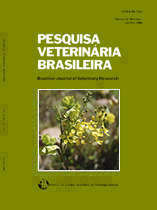 |
|
|
|
Year 2017 - Volume 37, Number 7
|

|
Antiviral and virucidal activity of hydroalcoholic extracts of propolis brown, green and Jataí bees (Tetragonisca angustula) against Bovine Herpesvirus Type-1 (BoHV-1) and Bovine Viral Diarrhea Virus (BVDV), 37(7):667-675
|
ABSTRACT.- Peter C.M., Picoli T., Zani J.L., Latosinski G.S., Lima M., Vargas G.D., Hübner S.O. & Fischer G. 2017. [Antiviral and virucidal activity of hydroalcoholic extracts of propolis brown, green and Jataí bees (Tetragonisca angustula) against Bovine Herpesvirus Type-1 (BoHV-1) and Bovine Viral Diarrhea Virus (BVDV).] Atividade antiviral e virucida de extratos hidroalcoólicos de própolis marrom, verde e de abelhas jataí (Tetragonisca angustula) frente ao Herpersvírus Bovino tipo 1 (BoHV-1) e ao Vírus da Diarreia Viral Bovina (BVDV). Pesquisa Veterinária Brasileira 37(7):667-675. Departamento de Veterinária Preventiva, Universidade Federal de Pelotas, Campus Capão do Leão, Avenida Eliseu Maciel s/n, Jardim América, Capão do Leão, RS 96900-010, Brazil. E-mail: cristina_peter@hotmail.com
Among the biological properties of propolis, the antimicrobial activity has received prominent attention. In this paper, we describe the antiviral and virucidal effect of three hydroalcoholic extracts of propolis (brown, green and jataí bees (Tetragonisca angustula), against bovine herpesvirus type-1 (BoHV-1) and bovine viral diarrhea Virus (BVDV). All hydroalcoholic extracts were obtained from ethanol extraction. The chemical composition of propolis extracts was determined by high-performance liquid chromatography coupled to mass spectrometer (UFLC-PDA-ESI-TOF/MS) to identify and quantify compounds such as caffeic acid and p-coumaric acid, chlorogenic acid, ferulic, and flavonoids such as rutin. Cell toxicity and antiviral activity of propolis extracts in monolayers of MDBK cells (Madin-Darby Bovine Kidney) were assessed by microscopic observation and quantified by the MTT assay (3- (4.5 dimethylthiazol-2yl) -2- 5-diphenyl-2H-tetrazolato bromine). Propolis extract from Jataí bees proved to be less cytotoxic (1.57mg / ml) when compared to green extracts (0.78mg / ml) and brown (0.39mg/mL). Regarding antiviral activity, propolis has shown greater efficacy in both cellular treatments (post and pre-exposure) against BoHV-1 when compared to other extracts, ie, there was increased cell viability compared to cell and virus controls. Extracts from Jataí showed activity against both viruses (BoHV-1 and BVDV) infection in the pre-test, whereas brown propolis demonstrated action only against the BoHV-1 in the pre-infection method. To determine the virucidal activity, it were used different dilutions of virus, as well as different temperatures and incubation times. The green propolis at 37°C led to a greater reduction in viral titer (4.33log) compared to brown (3.5log) and jataí (3.24log). Jataí propolis showed the best results in both temperatures (22oC and 37oC) when tested against BVDV. In summary, the evaluated extracts showed antiviral and virucidal activity against BoHV-1 and BVDV, and may be important targets for the development of new compounds as an alternative to commercial antivirals. |
| |
|
|
| |
|
 |